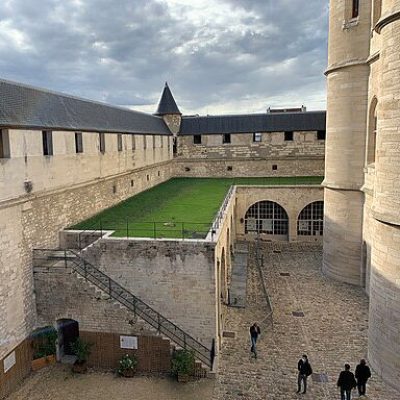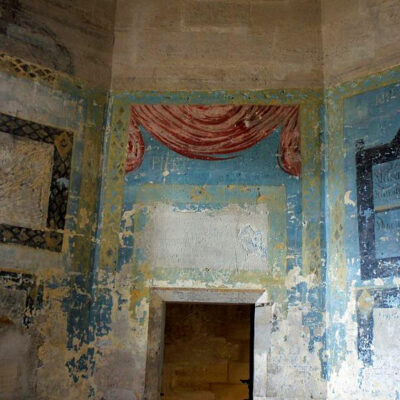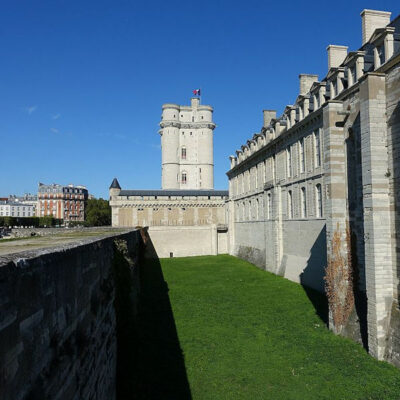History
Today, the Château de Vincennes consists of a chapel (Sainte-Chapelle de Vincennes), two towers, and a 14th century keep.The Château de Vincennes was originally used in Feudal France as a royal residence French monarchy during medieval times until King Louis the16th eventually moved the monarchy’s residence to Versailles.


During the Hundreds Years’ War (1337-1453), during the reign of Charles the 5th (Charles the Wise), the castle stood as a fortress that protected the capital and the royal family. Under Napoleon in the 18th century, it once again served as a fortress that protected Paris against outside threats. From the 16th to the 19th centuries, it served as a prison to many, including the infamous French writer Du Marquis De Sade. After World War Two, the structures were restored after withstanding significant damage. Today, the monuments serve as both a tourist attraction and a host of French historical armed forces services.
Artistic and Architectural Features

When visiting the Château de Vincennes, a visitor will discover both the castle/fortress/prison itself – along with an additional building that served as a chapel.
The castle has interesting remnants of intricate paintings that long ago lined the walls. Inside the former prison cell walls, old writing from former prisoners eerily remains – a few centuries later.

When visiting the Château de Vincennes, a visitor will discover both the castle/fortress/prison itself – along with an additional building that served as a chapel.
The castle has interesting remnants of intricate paintings that long-ago lined the walls. Inside the former prison cell walls, old writing from former prisoners eerily remains – a few centuries later.


Key Terms:
- Château – French word for a feudal castle or a structure built for defense (fortress).
- Moat – A deep trench around a castle that is usually full of water.
- Arrow Slit – An arrow slit is a vertical slit in a fortress, where an archer can launch arrows.
- Quoin – In French, quoin literally means “corner”. Usually decorative, a quoin can be found on an exterior or in an interior of a building (usually on the exterior).
- Turret – A turret is a small tower that is connected to a larger tower or a castle.
- Charles the Wise – French king from 1364 to 1380.
Some of the more interesting architectural features of the castle include areas resembling where moats may have once stood, gargoyle-like animal structures in the quoins inside of the castle, and small turrets on the roof of both the castle and the chapel. Interestingly, small arrow-slits can be seen throughout the ‘king’s hallway’ within the castle, where real archers may have shot arrows several centuries ago! The chapel itself is a beautiful, Gothic style royal chapel that is intricately adorned with very large stained-glass windows. Many of the windows display Biblical scenes of Revelations, as well as Henry the Second himself, kneeling in prayer.



You will need:
- Paper plate
- Scissors
- Sticky back plastic
- Colored tissue paper
- Paper or markers to decorate the frame
- Any stickers or other decorative items to decorate the frame
To decorate:
- Take a paper plate and fold in half.
- Cut out the middle to make a wreath shape.
- Place the sticky plastic on the back of the paper plate.
- Decorate! Put small pieces of tissue paper on the sticky side of the wreath. Decorate the frame.
Works Cited:
- Bureau, Paris Convention and Visitors. “Château De Vincennes – Paris Tourist Office.” En.parisinfo.com, https://en.parisinfo.com/paris-museum-monument/71070/Chateau-de-Vincennes.
- “Charles V.” Encyclopædia Britannica, Encyclopædia Britannica, Inc., https://www.britannica.com/biography/Charles-V-king-of-France.
- “Chateau of Vincennes – 2021 All You Need to Know Before You Go (with Photos).” Tripadvisor, https://www.tripadvisor.com/Attraction_Review-g790302-d194189-Reviews-Chateau_of_Vincennes-Vincennes_Val_de_Marne_Ile_de_France.html.
- “Château De Vincennes.” Centre Des Monuments Nationaux, https://www.chateau-de-vincennes.fr/en.
- Craven, Jackie. “Quoins in the Corners – a Common Architectural Detail.” ThoughtCo, ThoughtCo, 9 Apr. 2020, https://www.thoughtco.com/what-is-a-quoin-177497.
- “Sainte-Chapelle De Vincennes.” Wikipedia, Wikimedia Foundation, 21 Nov. 2021, https://en.wikipedia.org/wiki/Sainte-Chapelle_de_Vincennes.

